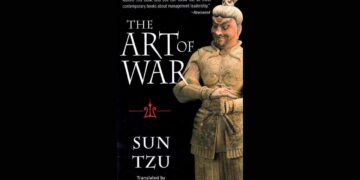Table of Contents
- Introduction
- Chapter 1: Laying Plans (The Calculations)
- Chapter 2: Waging War
- Chapter 3: Attack by Stratagem
- Chapter 4: Tactical Dispositions
- Chapter 5: Use of Energy (Momentum)
- Chapter 6: Weak Points and Strong
- Chapter 7: Maneuvering
- Chapter 8: Variation in Tactics
- Chapter 9: The Army on the March
- Chapter 10: Classification of Terrain
- Chapter 11: The Nine Situations
- Chapter 12: Attack by Fire
- Chapter 13: Use of Spies (Intelligence)
- Broader Themes of The Art of War
- Modern Applications of The Art of War
- Conclusion
- The Art of War by Sun Tzu – Famous Quotes
- Chapter 1: Laying Plans
- Chapter 2: Waging War
- Chapter 3: Attack by Stratagem
- Chapter 4: Tactical Dispositions
- Chapter 5: Energy (Momentum)
- Chapter 6: Weak Points and Strong
- Chapter 7: Maneuvering
- Chapter 8: Variation in Tactics
- Chapter 9: The Army on the March
- Chapter 10: Classification of Terrain
- Chapter 11: The Nine Situations
- Chapter 12: Attack by Fire
- Chapter 13: The Use of Spies
- Timeless Lessons from the Quotes
The Art of War by Sun Tzu: Book Summary and Analysis with Quotes & FAQs
Introduction
The Art of War by Sun Tzu is one of the most influential treatises on strategy ever written. Although it originated over 2,500 years ago in ancient China during the Eastern Zhou period, its insights on leadership, warfare, planning, and human behavior remain timeless. The text, divided into 13 concise chapters, does not just discuss military tactics but explores broader principles of decision-making, the psychology of opponents, the importance of adaptability, and the role of discipline and unity.
This 3500-word crux aims to provide a deep exploration of each chapter, drawing out the key lessons and applying them to both military and non-military contexts such as business, politics, negotiations, and personal life. Sun Tzu’s genius lies in the simplicity of his maxims combined with their profound practical applications.
Chapter 1: Laying Plans (The Calculations)
Sun Tzu begins by emphasizing the importance of planning before entering into conflict. War is not to be waged lightly; it is a matter of life, death, and survival of a state. Therefore, careful assessment is necessary.
He introduces five fundamental factors:
- The Moral Law – the harmony between rulers and people; a unified will.
- Heaven – environmental conditions like weather, timing, and seasons.
- Earth – distances, terrain, and logistical advantages.
- The Commander – leadership qualities such as wisdom, sincerity, courage, and discipline.
- Method and Discipline – organization of the army, chain of command, and logistical systems.
The commander who best understands and applies these principles will succeed. Planning involves comparing strengths and weaknesses—calculating not just the opponent’s army but also their morale, resources, and adaptability.
The lesson is clear: victory is won before the battle begins, through planning and preparation.
Chapter 2: Waging War
Sun Tzu warns of the high costs of war. Long campaigns drain resources, weaken states, and exhaust people. The wise leader seeks quick and decisive victories rather than prolonged conflict.
He outlines three crucial principles:
- Swift action reduces expenditure.
- Foraging from the enemy (capturing supplies rather than relying only on one’s own) strengthens sustainability.
- Capturing the enemy’s resources is better than destroying them.
Here Sun Tzu teaches that the greatest skill is to win while conserving energy and resources. Prolonged struggles create resentment, disunity, and vulnerability. The modern application is evident: prolonged business competition, political campaigns, or personal struggles can lead to burnout and resource depletion. Efficiency and decisiveness are more valuable than brute force.
Chapter 3: Attack by Stratagem
This chapter contains one of Sun Tzu’s most famous teachings: “The supreme art of war is to subdue the enemy without fighting.”
He identifies a hierarchy of victory:
- Overcome the enemy’s plans (the highest form).
- Disrupt alliances to weaken them.
- Engage in direct battle only when necessary.
He warns against destroying entire cities or armies unnecessarily—it wastes strength and damages long-term stability. The best leaders conquer through psychological dominance, manipulation, and diplomacy rather than outright violence.
Sun Tzu also distinguishes five essentials for victory:
- Knowing when to fight and when not to fight.
- Understanding both one’s own strengths and the enemy’s weaknesses.
- Maintaining morale and unity.
- Ensuring proper preparation.
- Having leadership free from interference or incompetence.
The takeaway: true victory is not merely physical conquest, but psychological and strategic dominance.
Chapter 4: Tactical Dispositions
Sun Tzu emphasizes that skillful commanders position themselves in such a way that defeat is impossible, while waiting for the enemy to present vulnerabilities.
Key principle: invincibility lies in defense; victory lies in the opportunity created by offense.
He insists that preparation creates strength—defense allows an army to remain unassailable, while offense depends on exploiting weaknesses when they arise. The wise commander does not seek glory in unnecessary risk but positions his army so securely that opportunities naturally present themselves.
The underlying wisdom: true strength is built on preparation, not reckless action.
Chapter 5: Use of Energy (Momentum)
Sun Tzu explains how discipline, coordination, and unity create force far greater than the sum of individual efforts.
He distinguishes between direct methods (frontal attacks, straightforward maneuvers) and indirect methods (surprise, deception, ambush). By combining these, a commander can create endless variations and keep the enemy guessing.
Sun Tzu compares this to musical notes or primary colors—few in number, but capable of infinite combinations. Similarly, energy in battle is about building momentum, much like water flowing downhill.
The broader application is clear: momentum in business, personal projects, or campaigns comes from careful coordination and combining direct effort with creative tactics.
Chapter 6: Weak Points and Strong
Here Sun Tzu explains the art of exploiting the enemy’s weaknesses while avoiding their strengths. The skilled commander maneuvers the enemy into disadvantageous positions through deception and manipulation.
He stresses adaptability: just as water has no constant shape, strategy must adapt to the situation.
This chapter contains the principle: “Appear at points the enemy must hasten to defend; march swiftly to places where you are not expected.”
Flexibility, unpredictability, and constant change prevent the enemy from formulating effective counter-strategies.
Chapter 7: Maneuvering
Sun Tzu now discusses the difficulty of movement and coordination in actual warfare. Moving an army requires careful timing, discipline, and avoiding confusion.
He emphasizes:
- Unity of command to prevent chaos.
- Avoiding exhaustion by overextending forces.
- Using terrain and deception to maneuver without unnecessary cost.
Importantly, he warns that direct confrontation is not always wise. Instead, maneuver forces into positions that make the enemy’s defeat inevitable, even without fighting.
This lesson applies universally: maneuvering in competition—be it business or politics—often matters more than direct clashes. Strategic positioning determines outcomes.
Chapter 8: Variation in Tactics
Rigid strategies lead to failure. Sun Tzu emphasizes the need for adaptability, warning against reliance on fixed rules. Circumstances change, and so must tactics.
He identifies five dangerous traits in a general:
- Recklessness (leads to destruction).
- Cowardice (leads to capture).
- Quick temper (leads to provocation).
- Sensitivity to honor (leads to shame or manipulation).
- Over-concern for troops (leads to hesitation).
The greatest generals balance caution with boldness, discipline with compassion, and firmness with flexibility.
Chapter 9: The Army on the March
Here Sun Tzu gives practical advice for interpreting signs in the environment and the behavior of enemy forces. He emphasizes the importance of terrain, local populations, and observation.
He notes:
- Dust patterns can reveal the size and movement of troops.
- Campfires indicate numbers and positions.
- The morale of soldiers can be judged by their behavior.
This chapter stresses awareness and intelligence. Success depends not only on one’s own strength but also on reading the environment and anticipating the opponent’s moves.
Chapter 10: Classification of Terrain
Sun Tzu identifies nine types of terrain, each requiring different strategies:
- Dispersive (close to home).
- Facile (easy ground).
- Contentious (strategically valuable).
- Open (accessible to all sides).
- Intersecting (shared by multiple parties).
- Serious (deep in enemy territory).
- Difficult (rough terrain).
- Hemmed-in (narrow passes).
- Desperate (where survival is at stake).
Each type requires unique handling. For example, in dispersive ground, soldiers are prone to retreat, while in desperate ground, they fight fiercely because survival depends on it.
This classification emphasizes adaptability once again: a commander must always align tactics with the environment.
Chapter 11: The Nine Situations
Building on the previous chapter, Sun Tzu applies terrain principles to broader campaigns. He describes how troops react differently depending on their position and level of commitment.
Most importantly, he explains the psychology of soldiers: troops fight hardest when they have no alternative, when survival itself is on the line.
This leads to the principle of “death ground”: placing troops in desperate situations forces them to fight with unmatched determination.
The leadership lesson is profound: sometimes leaders must create circumstances that push teams beyond comfort zones, awakening hidden strengths.
Chapter 12: Attack by Fire
Sun Tzu discusses the use of fire as a weapon, representing destruction and chaos. He categorizes five types of fire attack, including burning supplies, camps, or enemy morale.
The broader principle is about using the environment and psychological weapons to weaken the enemy. He emphasizes timing, weather, and careful coordination—using fire recklessly can backfire.
In modern contexts, “fire” can symbolize aggressive strategies, hostile takeovers, or disruptive innovation—powerful but dangerous if misused.
Chapter 13: Use of Spies (Intelligence)
The final chapter highlights the critical role of intelligence. Sun Tzu insists that all warfare is based on deception, and deception is impossible without accurate information.
He classifies five types of spies:
- Local spies.
- Inward spies.
- Converted spies.
- Doomed spies.
- Surviving spies.
The wise commander invests heavily in intelligence, using it to predict enemy actions and sow confusion.
The lesson: information is the ultimate weapon. In both war and life, those who know more and see deeper hold the true advantage.
Broader Themes of The Art of War
Beyond the 13 chapters, several universal themes run through Sun Tzu’s work:
- Strategy over brute force – intelligence, deception, and planning outweigh sheer numbers.
- Adaptability – rigid plans fail; success belongs to those who adapt fluidly.
- Psychology of conflict – morale, unity, and perception matter more than material strength.
- Efficiency and restraint – avoid unnecessary conflict; conserve energy for decisive moments.
- Leadership qualities – wisdom, discipline, and decisiveness separate victorious generals from failed ones.
Modern Applications of The Art of War
Though originally about warfare, Sun Tzu’s wisdom transcends the battlefield:
- Business strategy: corporations use Sun Tzu’s principles in market positioning, competition, and negotiations.
- Politics: leaders apply deception, alliances, and timing to gain advantage.
- Sports: coaches apply psychological dominance and adaptability in competitions.
- Personal growth: individuals apply discipline, planning, and adaptability to overcome challenges.
The endurance of The Art of War lies in its flexibility: it is not a rigid manual but a framework for thinking strategically in any domain.
Conclusion
The Art of War by Sun Tzu is not simply a book about war—it is a philosophy of life, strategy, and leadership. Its teachings on planning, deception, adaptability, and discipline remain timeless because they reflect fundamental truths about human conflict and competition.
At its core, Sun Tzu teaches us that the ultimate victory is not in fighting battles but in avoiding them altogether by mastering foresight, intelligence, and strategic dominance. The text’s lessons apply to war, business, politics, and personal challenges, reminding us that true power lies not in brute force, but in wisdom and strategy.
The Art of War by Sun Tzu – Famous Quotes
Chapter 1: Laying Plans
- “The art of war is of vital importance to the State. It is a matter of life and death, a road either to safety or to ruin.”
- “All warfare is based on deception.”
- “Know your enemy and know yourself and you can fight a hundred battles without disaster.”
- “If you know yourself but not the enemy, for every victory gained you will also suffer a defeat.”
Chapter 2: Waging War
- “There is no instance of a nation benefiting from prolonged warfare.”
- “In war, then, let your great object be victory, not lengthy campaigns.”
- “When you engage in actual fighting, if victory is long in coming, the men’s weapons will grow dull and their ardor will be damped.”
Chapter 3: Attack by Stratagem
- “The supreme art of war is to subdue the enemy without fighting.”
- “To fight and conquer in all your battles is not supreme excellence; supreme excellence consists in breaking the enemy’s resistance without fighting.”
- “He who wishes to fight must first count the cost.”
- “If you know the enemy and know yourself, your victory will not stand in doubt.”
Chapter 4: Tactical Dispositions
- “The good fighters of old first put themselves beyond the possibility of defeat, and then waited for an opportunity of defeating the enemy.”
- “Invincibility lies in the defense; the possibility of victory in the attack.”
- “To secure ourselves against defeat lies in our own hands, but the opportunity of defeating the enemy is provided by the enemy himself.”
Chapter 5: Energy (Momentum)
- “In battle, there are not more than two methods of attack—the direct and the indirect; yet these two in combination give rise to an endless series of maneuvers.”
- “The whole secret lies in confusing the enemy, so that he cannot fathom our real intent.”
- “The control of a large force is the same principle as the control of a few men: it is merely a question of dividing up their numbers.”
Chapter 6: Weak Points and Strong
- “So in war, the way is to avoid what is strong and to strike at what is weak.”
- “If he is secure at all points, be prepared for him. If he is in superior strength, evade him.”
- “Just as water retains no constant shape, so in warfare there are no constant conditions.”
Chapter 7: Maneuvering
- “Maneuvering with an army is advantageous; with an undisciplined multitude, most dangerous.”
- “Do not repeat the tactics which have gained you one victory, but let your methods be regulated by the infinite variety of circumstances.”
- “He who is prudent and lies in wait for an enemy who is not, will be victorious.”
Chapter 8: Variation in Tactics
- “The general who thoroughly understands the advantages that accompany variation of tactics knows how to handle his troops.”
- “In the wise leader’s plans, considerations of advantage and of disadvantage will be blended together.”
- “There are not more than five musical notes, yet the combinations of these five give rise to more melodies than can ever be heard.”
Chapter 9: The Army on the March
- “If soldiers are punished before they have grown attached to you, they will not prove submissive; and unless submissive, then they are practically useless.”
- “Regard your soldiers as your children, and they will follow you into the deepest valleys.”
- “If, however, you are indulgent, but unable to make your authority felt; kind-hearted, but unable to enforce your commands; and incapable, moreover, of quelling disorder: then your soldiers must be likened to spoiled children.”
Chapter 10: Classification of Terrain
- “We are not fit to lead an army on the march unless we are familiar with the face of the country—its mountains and forests, its pitfalls and precipices, its marshes and swamps.”
- “On dispersive ground, therefore, fight not. On facile ground, halt not. On contentious ground, attack not.”
- “The clever combatant looks to the effect of combined energy, and does not require too much from individuals.”
Chapter 11: The Nine Situations
- “Throw your soldiers into positions whence there is no escape, and they will prefer death to flight.”
- “Placed in death ground, they will live; placed in desperate straits, they will survive.”
- “Prohibit omens, and remove doubts, then until death itself comes, no calamity need be feared.”
Chapter 12: Attack by Fire
- “Move not unless you see an advantage; use not your troops unless there is something to be gained.”
- “Unhappy is the fate of one who tries to win his battles and succeed in his attacks without cultivating the spirit of enterprise; for the result is waste of time and general stagnation.”
- “When the flames are highest, follow it up with an attack, if that is practicable; if not, stay where you are.”
Chapter 13: The Use of Spies
- “Foreknowledge cannot be gotten from ghosts and spirits, cannot be had by analogy, cannot be found out by calculation. It must be obtained from men who know the enemy’s situation.”
- “Be subtle! Be subtle! and use your spies for every kind of business.”
- “An army without spies is like a man without ears or eyes.”
- “What enables the wise sovereign and the good general to strike and conquer, and achieve things beyond the reach of ordinary men, is foreknowledge.”
Timeless Lessons from the Quotes
The collected quotes emphasize the book’s three dominant ideas:
- Strategy over strength – win by foresight, deception, and positioning.
- Flexibility and adaptability – no rigid plan survives changing conditions.
- Leadership and morale – victory requires unity, trust, and psychological advantage.
FAQs
Q1: What is The Art of War about?
A: The Art of War is an ancient Chinese military treatise attributed to Sun Tzu. It covers strategy, tactics, leadership, deception, and adaptability in warfare, but its lessons are equally applied in business, politics, and personal life.
Q2: Why is The Art of War still relevant today?
A: The book’s timeless principles—planning, adaptability, understanding opponents, conserving resources, and psychological strategies—are universal. Leaders, executives, and negotiators use its teachings beyond the battlefield.
Q3: What is the most famous quote from The Art of War?
A: The most quoted line is: “The supreme art of war is to subdue the enemy without fighting.” It highlights that victory through strategy, diplomacy, or psychological dominance is greater than physical battle.
Q4: How many chapters are in The Art of War?
A: The book consists of 13 chapters, each focusing on a different aspect of warfare and strategy—from planning and maneuvering to intelligence and leadership.
Q5: What are the five fundamental factors of war according to Sun Tzu?
A: The five factors are:
- The Moral Law (unity between ruler and people)
- Heaven (weather, timing, seasons)
- Earth (terrain, distance, logistics)
- The Commander (leadership qualities)
- Method and Discipline (organization and structure).
Q6: What does Sun Tzu mean by “all warfare is based on deception”?
A: Sun Tzu emphasizes that misleading the enemy—appearing weak when strong, creating confusion, and striking unexpectedly—gives a strategic advantage. Deception reduces the enemy’s ability to plan effectively.
Q7: How does Sun Tzu view prolonged war?
A: He warns against it, stating: “There is no instance of a nation benefiting from prolonged warfare.” Long wars drain resources, weaken morale, and harm the state. The goal should be swift, decisive victories.
Q8: Can The Art of War be applied outside of the military?
A: Absolutely. The principles of planning, strategy, adaptability, and intelligence apply to business, leadership, negotiations, sports, and even personal decision-making. Many entrepreneurs and executives rely on Sun Tzu’s wisdom.
Q9: What qualities make a great leader according to Sun Tzu?
A: A great leader embodies wisdom, sincerity, benevolence, courage, and strict discipline. Leadership is not just about command but also about earning loyalty and guiding with fairness and foresight.
Q10: Why is intelligence (spies) so important in The Art of War?
A: Sun Tzu concludes his work by stressing the importance of intelligence. He argues: “An army without spies is like a man without ears or eyes.” Information about the enemy ensures preparedness and enables successful deception.
Q11: What is “death ground” in Sun Tzu’s philosophy?
A: “Death ground” refers to situations where soldiers have no escape or alternative but to fight. In such desperate conditions, troops show maximum courage and determination, often leading to extraordinary victories.
Q12: What is the overall lesson of The Art of War?
A: The key takeaway is that victory depends not on brute force but on strategy, foresight, adaptability, and psychological strength. The best general wins without fighting by making conflict unnecessary.




















